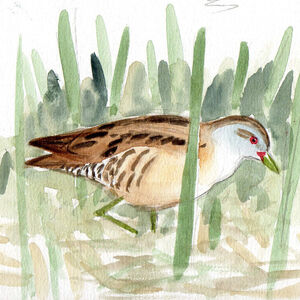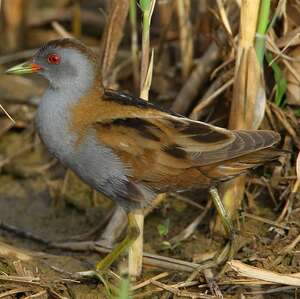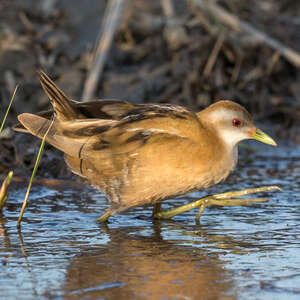Little Crake
Zapornia parva - Marouette poussin
Identification
The Little Crake is a small rail, about the size of a starling, that leads a hidden life among marshy formations and is therefore very difficult to observe correctly in its breeding grounds.
The species is dimorphic. The adult male has a vivid chamois brown all over its upper parts, marked with dark brown and white. The sides of the head, the front of the neck, the chest and the upper belly are a beautiful bluish grey. The back of the flanks is striped with white and the undertail with black and white. The iris is a vivid red. The beak and the legs are yellowish green, the former with a bit of red at the commissure.
The adult female differs from the male by its chamois reddish lower parts. The flanks and undertail are less clearly striped. The throat is white. The eyebrow and cheeks are light grey.
The chick is black. The juvenile looks like the female but can be recognized by its lower parts clearly striped with brown. The top is more white marked. The sides of the head are whitish. The iris is a less vivid red.
Subspecific information monotypic species
Foreign names
- Marouette poussin,
- Polluela bastarda,
- franga-de-água-bastarda,
- Kleinsumpfhuhn,
- kis vízicsibe,
- Klein Waterhoen,
- Schiribilla,
- mindre sumphöna,
- Sumprikse,
- chriašť malý,
- chřástal malý,
- Lille Rørvagtel,
- pikkuhuitti,
- Europese Kleinriethaan,
- rascletó,
- Flóðrella,
- zielonka,
- mazais ormanītis,
- mala tukalica,
- Малый погоныш,
- コクイナ,
- 姬田鸡,
- mindre sumphöna,
- 姬田雞,
Voice song and call
At nightfall, the male often begins to sing, taking advantage of the quiet sound that settles in at this moment. The song is typical. It is a succession of quik emitted every two seconds or so at the beginning. Then the emission rate accelerates while the intensity decreases and the tone changes, for example quik..... quik..... quik.... quik... quik.. quink.. quinc.quinc.quinc quincquincquincquinc..., with variations on this pattern. The song is louder than during the day, and can be heard more than one kilometer away when there is no wind.
The base note of the call resembles a syllable of singing, for example quek These calls are emitted at a frequency that reflects the state of the birds. The alarmed male emits rapid quekquekquekquekquek... that decrease in intensity. The female, on the other hand, gives out sharp, jerky brrrrrrrrr when she is excited.
Habitat
During the breeding season, the Little Crake inhabits tall marsh vegetation growing in shallow fresh-water bodies with large helophytes such as Phragmites, Typha, Common Reedmaces, Glyceria aquatica, etc.
Less complex marshy places are frequented during the migratory stop-overs or wintering quarters. Then, one can have the opportunity to observe it outside of vegetal cover.
Behaviour character trait
The Little Crake leads a discreet life in marsh vegetation. If it weren't for its voice, it would go unnoticed.
Furthermore, its nocturnal migratory movements escape observation. Suffice it to say that we have to rely on luck to observe this species properly.Like all crakes, the Little Crake does not show any tendency to gregariousness as is the case with other rallids. The largest groups are family gatherings at the end of the breeding period. Otherwise, it's solitary.
Nature has endowed it with long wings for its long-distance movements to its southern wintering grounds. Our Little Crakes cross the Sahara. It is also equipped with long legs and long fingers that allow it to move in very well flooded marsh vegetation and even to swim.
Flight
Dietfeeding habits
Reproduction nesting
The Little Crake species is monogamous. Reproduction is achieved by territorial couples that inhabit within marsh vegetation.
The male defines the territory through his song which attracts the female.The couple builds the nest above or near the water, in a clump of vegetation or on a pile of dead elements. It is a platform of 15-20 cm in diameter, made of stems and leaves, with a chamber where the eggs are laid.
The female lays 7-9 speckled eggs. Incubation lasts 21-23 days, with the couple helping out. Hatching happens at different times, showing that incubation starts with the first egg. The black-fuzzy chicks quickly move through the surrounding vegetation, where they are fed by their parents. They are able to fly in about 50 days, but are already independent from the adults.
Geographic range
The Little Crake is a species of the Western Palearctic, nesting at middle latitudes from northern France to the western tip of China. In the north, Scandinavia is only occupied in southern Finland. To the south it does not nest in Spain or Turkey. In France it is very rare. Its wintering area covers Africa south of the Sahara, the Nile delta, occasionally the Arabian peninsula, and the north of the Persian Gulf.
Threats - protection
IUCN conservation status
concern
in the Wild
threatened
evaluated
The Little Crake is dependent upon wetland vegetation in balance with a water level for reproduction. Any damage or alteration to these two parameters can directly impact the species. For example, the maintenance of fishponds can tend to reduce the belt of vegetation favorable to the species. During a year of strong rainfall deficit, the water level may be insufficient for either the establishment or the maintenance of the species.
On the other hand, the creation of bodies of water, as was the case for fish farming in Hungary in the 20th century, could only have had a positive impact.
In any case, it is very difficult to document a trend with a species like this, which one cannot visually control.
Sources of information
- IOC World Bird List (v15.1), Gill, F and D Donsker (Eds). 2025-12-07.
- Birds of the World, The Cornell Lab of Ornithology
- xeno-canto, Sharing bird sounds from around the world,
- Grands échassiers, gallinacé, râles d'Europe, Paul Géroudet (mise à jour Georges Olioso)
Other sources of interest
 Specification sheet created on
27/07/2023 by Jean François
Specification sheet created on
27/07/2023 by Jean FrançoisTranslation by AI Oiseaux.net
© 1996-2026 Oiseaux.net
- Accipitriformes
- Aegotheliformes
- Anseriformes
- Apodiformes
- Apterygiformes
- Bucerotiformes
- Caprimulgiformes
- Cariamiformes
- Casuariiformes
- Charadriiformes
- Ciconiiformes
- Coliiformes
- Columbiformes
- Coraciiformes
- Cuculiformes
- Eurypygiformes
- Falconiformes
- Galliformes
- Gaviiformes
- Gruiformes
- Leptosomiformes
- Mesitornithiformes
- Musophagiformes
- Nyctibiiformes
- Opisthocomiformes
- Otidiformes
- Passeriformes
- Pelecaniformes
- Phaethontiformes
- Phoenicopteriformes
- Piciformes
- Podargiformes
- Podicipediformes
- Procellariiformes
- Psittaciformes
- Pterocliformes
- Rheiformes
- Sphenisciformes
- Steatornithiformes
- Strigiformes
- Struthioniformes
- Suliformes
- Tinamiformes
- Trogoniformes






























